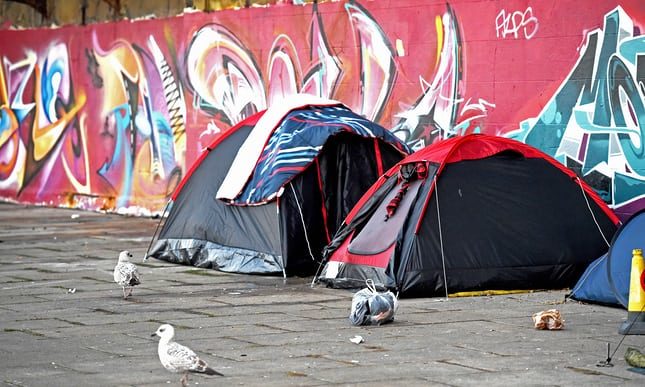
A total of 123,130 children were housed in temporary accommodation in England in the first quarter of 2018, an increase of nearly 80% since 2011. The number of people accepted as homeless over the age of 60 has increased by 40% in the last year, reaching 2,520. There has also been a significant rise in the number of homeless single parents.
Campaigners have blamed government welfare cuts, lack of affordable housing and rising rents for the growing number of homeless people housed in temporary accommodation by the state.
Polly Neate, the chief executive of the homelessness charity Shelter, said: "It's clear that our country is in the firm grip of a housing crisis as these figures starkly show, with older people and single parents both bearing the brunt.
"Something as simple as a family breakdown can push older people from a shared family home into private renting, yet huge rents and unforgiving welfare cuts mean they lose their homes."
The number of households living in temporary accommodation in England reached 79,800 in the first three months of 2018, up 56% from 2010. Households headed by a single parent account for just under a quarter of all families in England but make up 56% of families in temporary accommodation.
The most common specified causes of homelessness were relatives and friends not being able to provide accommodation, relationship breakdown with a violent partner and the end of a shorthold tenancy, according to the figures released by the Ministry of Housing, Communities and Local Government.
Jon Sparkes, the chief executive of Crisis, said: "While we welcome steps the government has taken around preventing homelessness, today's figures are a stark reminder that there are still far too many people who are homeless and stuck in temporary accommodation or being placed in sub-standard and sometimes dangerous B&Bs.
"Every day we see first-hand the effects of long stays in these types of accommodation; people can become isolated, with little access to vital support services, in poor conditions with nowhere to wash clothes or cook ... we're calling on the government to take swift action to tackle the problem and fix it once and for all."
Rough sleeping in England increased for a seventh consecutive year in 2017, reaching 4,751 people, although the true figure is believed to be much higher. Rough sleepers in London accounted for almost a quarter of the national figure last year, but substantial rises were recorded in Greater Manchester, Oxford, Swindon, Hastings and Peterborough.
Labour blamed government policies for the rise in people in temporary accommodation and said Conservative ministers should be ashamed of their record on homelessness.
John Healey , the shadow housing secretary, said: "This is a direct result of Conservative decisions: a steep drop in investment for affordable homes, cuts to housing benefit, reduced funding for homelessness services and a refusal to help private renters."
The homelessness minister, Nigel Adams, said: "Everyone deserves a safe and secure place to live. "We're investing £1.2bn to support those who are homeless and have brought in the most ambitious legislation in decades to help prevent people at risk of homelessness.
"There are encouraging signs that this concerted action is beginning to make a difference - homelessness acceptances are down 6% on the same quarter last year and fewer vulnerable people, including children, are in B&Bs. But it's clear we have more to do."



Reader Comments
to our Newsletter